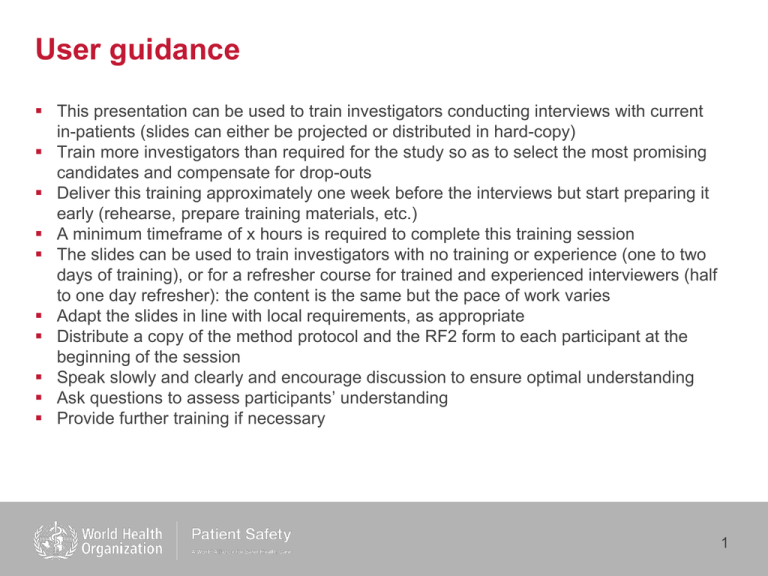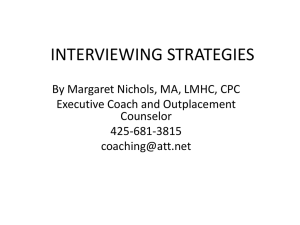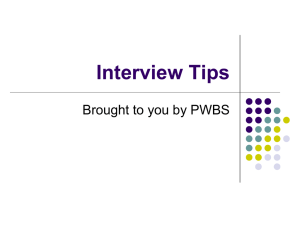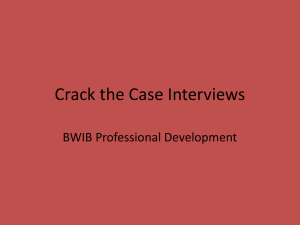Training pack to use with staff interviewers
advertisement

User guidance This presentation can be used to train investigators conducting interviews with current in-patients (slides can either be projected or distributed in hard-copy) Train more investigators than required for the study so as to select the most promising candidates and compensate for drop-outs Deliver this training approximately one week before the interviews but start preparing it early (rehearse, prepare training materials, etc.) A minimum timeframe of x hours is required to complete this training session The slides can be used to train investigators with no training or experience (one to two days of training), or for a refresher course for trained and experienced interviewers (half to one day refresher): the content is the same but the pace of work varies Adapt the slides in line with local requirements, as appropriate Distribute a copy of the method protocol and the RF2 form to each participant at the beginning of the session Speak slowly and clearly and encourage discussion to ensure optimal understanding Ask questions to assess participants’ understanding Provide further training if necessary 1 Slides to train investigators conducting staff interviews on current in-patients <insert your name, title and affiliation> 2 What and how will you learn? What: Patient safety and the WHO initiative Key concepts of patient safety The objective and process of a staff interview Your role as an interviewer How to excel in your role: do's and don'ts How: Facilitator-led presentation Questions and discussions Quiz Hands-on exercise 3 What is patient safety? Freedom from accidental injuries during medical care Activities to avoid, prevent or correct any adverse outcomes which may result from the delivery of health care 4 Why is patient safety important? Every year tens of millions of patients suffer disabling injuries or death due to unsafe medical care In developed countries 1 in 10 patients is harmed while receiving hospital care We know little for developing countries but evidence suggests that they are even more affected by patient harm The consequences are millions of devastated lives and billions of dollars unnecessarily spent on prolonged hospitalization, loss of income, disability and litigation 5 The initiative of the World Health Organization Against this backdrop, the World Health Organization called into life the World Alliance for Patient Safety in 2004 The Alliance pays particular attention to patient harm in developing and transitional countries Since fact-based knowledge is often rare in such contexts, the Alliance has developed simple methods to help local practitioners and researchers assess and tackle patient harm in data-poor environments You can contribute to successfully conducting one of these methods by acting as a nominal group meeting facilitator 6 What are staff interviews on current in-patients? What: a trained interviewer asks local care givers (nurse and doctor/physician in charge of in-patients) questions on local in-patients and sscreening of relevant documents (if available) Why: either to estimate the prevalence of harmful incidents and understand their causes or to monitor and improve patient safety achievements How: the interviewer uses harmful incidents detection criteria and a questionnaire How long: interviewing local staff for a 30-bed ward requires approximately one day 7 Key concepts Harmful Incident (HI) Unintended injury or complication Prolonged admission, disability at discharge or death Caused by health-care management rather than the disease process May or may not be preventable or caused by negligence (e.g. post-operation wound infection) 8 Key concepts Prevalence of HIs the ratio on the day of data collection of the number of cases with HIs to the total number of cases: number of HIs x 100 number of screened records Preventability Harm would not have arisen if standard levels of care had been used or Incident is preventable if reasonable steps to prevent this occurrence can be identified 9 Key concepts In-patient Patient admitted to a healthcare facility for treatment that requires at least one overnight stay Contributing factor A factor in an event, effect, result or outcome which is similar to a cause and can relate to the Patient (e.g. co-morbidities) Task (e.g. lack of guidelines/protocols or their use) Individual (e.g. lack of knowledge) Team (e.g. poor team-work) Environment (e.g. defective or unavailable equipment) Organisation (e.g. poor coordination of overall services) 10 The process of staff interviews Phase Interviews with nurse Interview with doctor/physician Specifications Why to: select cases with high likelihood of HIs and reduce number of cases that need to be discussed with doctor/physician Why: to closely examine in-patient cases that have been earmarked as ‘high-risk’ cases What: interview nurse supervisor/ward nurse and screen any available documents (at the least, the admission notes and discharge summary, if available) How: based on detection criteria provided in method protocol How long: x hours for x patient cases What: interview doctor/physician and screen any available documents for evidence of HIs, preventability, contributing factors and nature of HIs, among other issues How: based on a comprehensive questionnaire (RF2) How long: x hours for x patient cases 11 Your role: overview of tasks* 1. Before the interview: prepare to explain and conduct the interviews and arrange meeting room and materials 2. Upon arrival at the health-care facility: be introduced to supervisor/ward nurse and doctor/physician, reassure them of confidentiality, explain objective and procedure of staff interviews and provide definition of HIs 3. Write list of names and gather available records 4. Interview nurse and examine records for specific criteria (p. x of method protocol) 5. Complete RF2 form for each ‘high-risk’ case, ensure forms are completed as fully as possible and destroy list of names and first pages of RF2 forms 6. Calculate incidence of HIs and compare results to those of previous assessments (only if the objective is to monitor and improve past patient safety achievements) 7. Return all records, explain next steps, thank involved staff and present results to facility managers * more comprehensive guidance is provided in the method protocol 12 How to excel in your role: do… discuss with the principal investigator any parts of the RF2 questionnaire you are unclear about conduct the interviews in a calm environment and avoid interruptions allow time to build a relationship of trust with the respondent inform respondents that the objective is to examine cases of in-patients and not to test them follow the detection criteria and the RF2 questionnaire as much as possible but provide further explanations if needed speak slowly and use understandable language leave respondents enough time to think use follow-up questions until a question is clarified or can definitely not be answered 13 How to excel in your role: don’t… be nervous: the respondent is probably more nervous than you forget that the primary objective is to assess the situation and not to teach staff how to do things conduct the interview in presence of respondents’ colleagues whenever possible (social desirability bias) pressurize respondents or try to influence their answers ask ‘leading questions’ (e.g. ‘This HI wasn’t preventable, don’t you think?’) ask embarrassing or unnecessary questions let your note-taking get in the way of listening to the respondent: first listen, then take notes wait before cleaning up and completing your notes or you will forget information 14 Questions? Comments? 15 Quiz Instructions • Not a pass/fail test but an opportunity to identify areas that require further discussion or training • Participants discuss each question in small groups (you can use your method protocol), followed by each group presenting its answers and by a general discussion led by the facilitator, who clarifies any unanswered questions Questions • Explain the concepts of patient safety, HIs, preventability and contributing factors in your own words and give examples for each • Summarize the objective and process of staff interviews • Describe the tasks you will be performing step-by-step • Discuss how you can best ensure that the do‘s and don’ts are respected 16 Hands-on exercise 1. Participants split into small groups to simulate interviews. An interviewer and a nurse/doctor are selected for each group, the rest of the group watches. 2. The interviewer interviews the nurse and consults sample medical records (provided by the trainer) to determine for each case whether HIs are present or not (based on detection criteria). 3. For all positively screened cases, the interviewer completes the RF2 form based on an interview with the doctor (and possibly medical records). 4. At the end of each interview, those group members who have watched the simulation give feedback on the strengths and weakness of the simulation. As many participants as possible act as interviewers and nurses/doctors. 5. At the end of the simulation session, each group explains the problems they have faced and the lessons they have learned. The trainer clarifies potential questions. 17 Further information For further information, questions or comments contact <insert your name and telephone number or email> Visit the Patient Safety Programme (Research) website at: http://www.who.int/patientsafety/research/en/ 18







